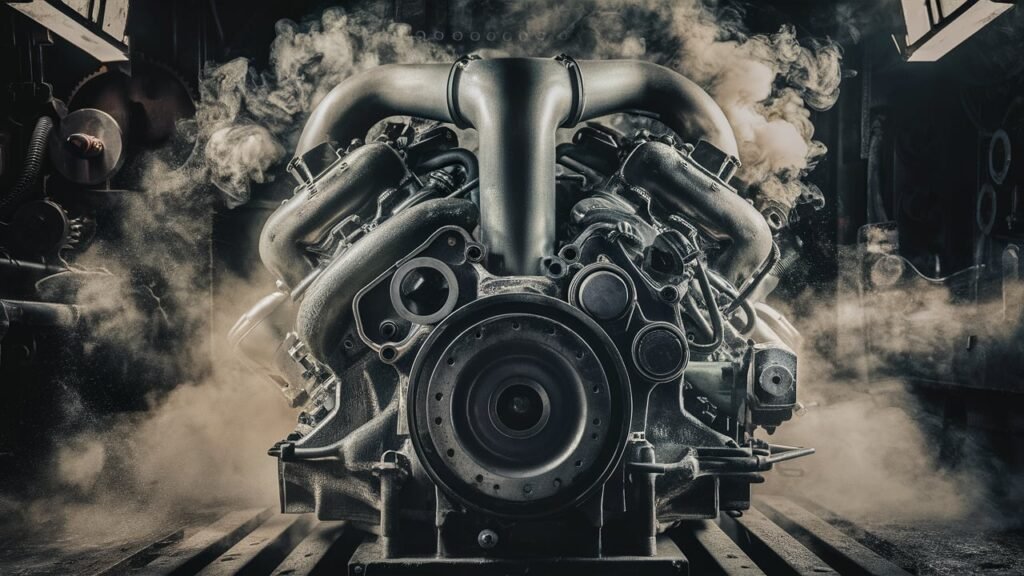
Unraveling the Mechanics of a Car Engine Serpentine Belt
In the intricate ecosystem of a vehicle’s engine, a vital yet often overlooked component quietly orchestrates the harmonious operation of various mechanical functions—the serpentine belt. As an unassuming but crucial link in the automotive chain, the serpentine belt plays a pivotal role in efficiently transmitting power from the engine to essential components like the alternator, water pump, power steering pump, and air conditioning compressor.
Fusing engineering precision with functional necessity, understanding the mechanics of a car engine serpentine belt unveils a world where motion is meticulously directed and power impeccably distributed.
Defined as a single continuous belt that winds its way through an engine’s pulleys, the serpentine belt epitomizes efficiency by driving multiple systems simultaneously to sustain optimal vehicle performance. This engineered marvel serves as an imperative cog in the intricate machinery of an automobile, translating rotational force into practical energy for essential functions.
Diving deeper into the labyrinthine circuits of automotive engineering illuminates how this unassuming strip of material exerts profound influence over the dynamic symphony of interconnected parts that propel every journey forward.
Embark on an expedition into the inner workings of this seemingly unremarkable yet irreplaceable component, where precision meets purpose and mechanics merge seamlessly to drive innovation under every hood.
Understanding Serpentine Belts.
A car engine serpentine belt, often referred to as a drive belt, is a vital component responsible for transferring power from the engine to various auxiliary components in a vehicle’s system. Structurally, these belts are long and flat, typically made of durable materials like EPDM rubber compounds reinforced with polyester cords.
The design resembles a snake winding its way around pulleys connected to different systems within the engine bay. This unique layout enables a single serpentine belt to drive multiple components efficiently.
The functions performed by a serpentine belt are diverse and crucial for the vehicle’s operation. As the engine runs, the belt drives essential parts such as the alternator, responsible for charging the battery; the water pump, circulating coolant to regulate engine temperature; the power steering pump, aiding in easier steering control; and the air conditioning compressor, ensuring proper cooling inside the car during hot weather. Each component plays a pivotal role in maintaining optimal performance and safety while driving.

Regular inspection and maintenance of serpentine belts are imperative to avoid sudden failures that can lead to breakdowns or costly repairs. Over time, wear and tear can cause cracks or fraying on the surface of the belt, affecting its ability to grip pulleys effectively.
By inspecting for signs of damage periodically and replacing worn-out belts preemptively, drivers can prevent unexpected failures on the road. Additionally, ensuring proper tension in the belt is vital since overtightening or slackness can result in inefficiencies or premature wear on both the belt and related components.
In essence, understanding how serpentine belts function within a vehicle’s engine system sheds light on their significance for overall performance and reliability.
By grasping their structure, functions, and maintenance needs adequately, auto enthusiasts, mechanics, and engineering students can appreciate the intricate yet essential role that these seemingly simple belts play in powering numerous components that keep cars running smoothly.
Materials Used in Serpentine Belts.
Serpentine belts, the unsung heroes of a vehicle’s engine system, are typically crafted from a blend of rubber compounds that offer flexibility and durability. These industrial-strength rubbers are specifically formulated to withstand the rigors of daily use while maintaining their shape and integrity under varying temperatures and conditions.
The high-quality rubber used in serpentine belts prevents premature cracking or snapping, ensuring optimal functioning of key engine components like the alternator and water pump. Polyester cords are often integrated within the rubber matrix to provide added strength and reduce stretching, contributing to the longevity of the belt.
In addition to rubber compounds and polyester cords, serpentine belts may feature fiber coatings to enhance grip and minimize slippage on pulleys. These fiber coatings serve as a frictional interface between the belt and pulleys, enabling efficient power transfer from the crankshaft to auxiliary systems like the power steering pump or air conditioning compressor.
The selection of materials for serpentine belts is crucial in determining their overall performance and longevity. For instance, vehicles operating in extreme climates may require belts with enhanced heat resistance properties, while heavy-duty applications might necessitate belts with higher tensile strength to withstand greater loads without deformation.
Manufacturers consider various factors when selecting materials for serpentine belts based on specific vehicle models or operating conditions. Factors such as load capacity, temperature range, vibration resistance, and chemical exposure influence material choices to ensure optimal performance over extended periods.
By carefully evaluating these aspects during the material selection process, engineers can tailor serpentine belts for diverse applications—from compact sedans to robust trucks—ensuring reliability and efficiency across different automotive platforms.
Ultimately, the meticulous choice of materials underscores the critical role they play in enhancing the functionality and longevity of modern engine serpentine belt systems.
Installation and Tensioning Techniques.
Installing a new serpentine belt correctly is crucial for the efficient performance of a vehicle’s engine system. Here is a step-by-step guide to help you with the installation process:
1. **Locate the Belt Path**: Begin by locating the belt routing diagram usually placed near the front of the engine compartment. This diagram illustrates how the serpentine belt should be threaded around various pulleys.
2. **Determine the Adjustment Point**: Identify the tensioner pulley, which is responsible for maintaining proper tension on the serpentine belt. The tensioner can usually be adjusted using a wrench or a specialized tool designed for this purpose.

3. **Remove the Old Belt**: Carefully release tension from the old belt by rotating or moving the tensioner in its operating direction to create slack. Slide off the old belt from one of the pulleys, making note of its routing path before complete removal.
4. **Install the New Belt**: Follow the belt routing diagram and start threading the new serpentine belt around each pulley according to the specified path. Ensure that each ribbed side of the belt matches with grooved surfaces on pulleys.
Proper tensioning plays a critical role in preventing slippage and premature wear of a serpentine belt. Using adequate force to set optimal tension levels will enhance longevity and ensure optimal performance while reducing strain on surrounding components.
For tensioning adjustments, specialized tools like a tensioner gauge are typically used to accurately measure and adjust belt tightness as per manufacturer specifications. Best practices include double-checking alignment post-installation and verifying tension levels after running your vehicle for some time to allow for settling into position seamlessly.
By following these steps diligently, you can ensure that your serpentine belt operates smoothly within your engine system, enhancing overall efficiency and longevity while minimizing maintenance issues down the road.
Common Issues and Troubleshooting.
Serpentine belts, while integral to the smooth operation of a vehicle’s engine system, can encounter several common issues that necessitate troubleshooting. One prevalent problem often faced by car owners is the occurrence of squeaking noises emanating from the belt area.
This high-pitched sound can be indicative of tension issues or wear on the belt itself. To address this, it is advisable to first check the tension of the serpentine belt using a tension gauge, ensuring it meets manufacturer specifications. Additionally, inspecting for signs of wear, such as cracks or fraying, can help diagnose potential causes of the noise accurately.
Misalignment is another issue that can arise with serpentine belts, potentially leading to premature wear and slippage. An effective troubleshooting technique involves visually inspecting the alignment of pulleys along the belt path to ensure they are correctly positioned in relation to each other.
Adjustments may be needed to realign any components causing misalignment, thereby preventing undue stress on the belt and improving its longevity.

For those encountering abnormal noises like grinding or clicking sounds related to their serpentine belt system, thorough troubleshooting is crucial. These sounds could signal underlying issues such as damaged pulleys or bearings within ancillary components driven by the serpentine belt.
In such cases, a systematic inspection of each driven component—such as alternators or idler pulleys—and their associated bearings can aid in pinpointing the source of the abnormal noise for targeted repairs.
To prevent these common issues from occurring prematurely and prolong the lifespan of a serpentine belt, adopting preventive measures is essential. Regular inspections for wear and tear, as well as monitoring tension levels according to manufacturer guidelines, can help preempt larger problems down the line.
Furthermore, ensuring proper alignment of all related components and addressing any abnormal noises promptly through professional diagnosis can not only extend the life expectancy of a serpentine belt but also contribute to overall engine system efficiency.
By implementing these preventive strategies proactively, individuals can mitigate potential interruptions due to serpentine belt malfunctions and maintain optimal performance in their vehicles.
Replacing Serpentine Belts: Procedure.
When it becomes evident that a serpentine belt is worn out or damaged beyond repair, replacing it in a timely manner is crucial to maintain the smooth operation of the engine system. Begin by consulting the vehicle’s manual for specific instructions regarding belt replacement.
Prior to initiating the replacement process, ensure the engine is turned off and has had sufficient time to cool down. Safety goggles are recommended to protect your eyes from debris dislodged during the procedure.
To efficiently replace a serpentine belt, start by locating the belt routing diagram within the engine compartment or refer to the manual for guidance on how the new belt should be installed.
Next, use appropriate tools as per manufacturer recommendations, which may include a breaker bar or wrench for adjusting tension levels. Carefully thread the new belt around pulleys following the correct path outlined in the diagram until it fits snugly into place.
During installation, make sure that all pulleys align correctly with their grooves and that there are no twists in the belt. Once installed, assess the tension of the serpentine belt by applying pressure with your hand; there should be an optimal level of deflection based on specifications provided by the manufacturer.
Adjust tension accordingly using designated adjustment points until achieving proper alignment to prevent slippage or premature wear.
After securing the new serpentine belt, start up your vehicle and listen for any abnormal noises that could indicate misalignment or inadequate tensioning. Take note of whether all components powered by the serpentine belt function smoothly without any issues.
Regularly check for signs of wear or unusual sounds in subsequent drives to ensure that the newly replaced serpentine belt continues to operate effectively without causing any disruptions to your engine system.
Maintenance Best Practices.
To ensure the longevity and optimal performance of your car’s serpentine belt, adhering to a schedule of regular maintenance tasks is crucial. Experts recommend inspecting the serpentine belt every 25,000 to 50,000 miles or at least annually. During these inspections, check for signs of wear, fraying, cracks, or glazing on the belt surface.
Visual cues like these can indicate that it’s time for a replacement before any catastrophic failure occurs. Keeping an eye out for these warning signs during routine maintenance can save you from unexpected breakdowns and costly repairs down the line.

Regular cleaning is another maintenance practice that can aid in prolonging the life of your serpentine belt. Dust, debris, and oil build-up can accelerate wear and tear on the belt. Therefore, as part of your routine inspection, gently clean the belt using a cloth dampened with mild soap and water to remove any contaminants that might affect its traction and efficiency.
By incorporating simple cleaning steps into your maintenance routine, you contribute to the overall health and functioning of your vehicle’s engine system.
Proactive maintenance not only extends the life expectancy of your serpentine belt but also reduces the likelihood of more severe issues arising in other components driven by the belt.
By adhering to recommended inspection intervals and promptly addressing any concerns found during these checks, you prevent minor problems from escalating into major malfunctions that could leave you stranded on the road or incur hefty repair bills.
Remember that being proactive about maintaining your car’s serpentine belt not only ensures smooth driving but also provides peace of mind knowing that your vehicle is operating at its best.
Conclusion.
In conclusion, understanding the complexities of a car engine serpentine belt is crucial for ensuring the efficient operation of a vehicle’s key components.
The detailed exploration of the structure, functions, materials, installation techniques, common issues, and maintenance practices related to serpentine belts provides auto enthusiasts, mechanics, and engineering students with a comprehensive overview of this essential engine system element.
By adhering to recommended maintenance schedules and adopting proper installation and tensioning techniques, individuals can mitigate common problems like belt misalignment or premature wear. Regular inspection and proactive upkeep not only enhance the longevity of the serpentine belt but also contribute to overall vehicle performance and reliability.
This in-depth analysis underscores the significance of treating the serpentine belt as a fundamental component that powers critical systems within a vehicle. By following best practices outlined in this article and staying attuned to signs of potential issues, automotive enthusiasts can navigate through the intricacies of maintaining and replacing serpentine belts successfully.
Embracing a disciplined approach to care for this integral part will ultimately translate into enhanced safety on the road, improved mechanical efficiency, and prolonged lifespan for both the belt itself and the interconnected engine components it drives.




